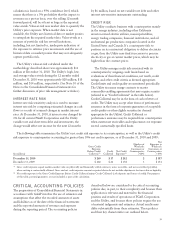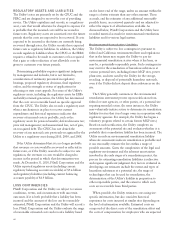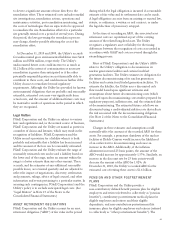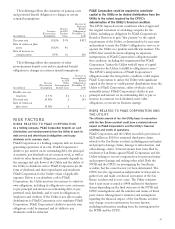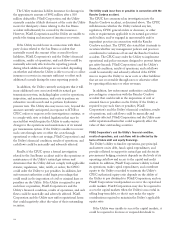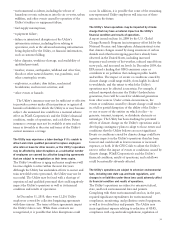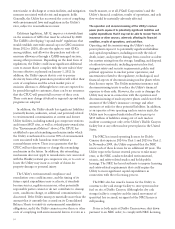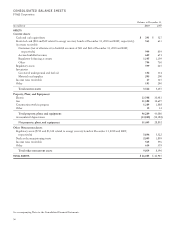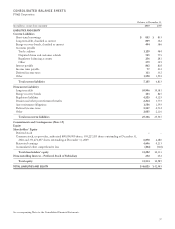PG&E 2010 Annual Report Download - page 52
Download and view the complete annual report
Please find page 52 of the 2010 PG&E annual report below. You can navigate through the pages in the report by either clicking on the pages listed below, or by using the keyword search tool below to find specific information within the annual report.If the CPUC fails to adjust the Utility’s rates, including
non-bypassable charges, to reflect the impact of changing
loads, PG&E Corporation’s and the Utility’s financial
condition, results of operations, and cash flows could be
materially adversely affected.
If the new day-ahead, hour-ahead, andreal-time wholesale
electricity markets that became effective inCalifornia during
2009 do not continue to functioneffectively, orif the Utility
incurs costs to adapt to future changes to the rules governing
these markets orlosses inconnectionwith congestioncharges,
and these costs and losses arenot recoverable, PG&E
Corporation’s and the Utility’s results of operations, financial
condition,and cash flows could be negatively impacted.
On April 1, 2009, the California Independent System
Operator (“CAISO”) implemented MRTU, resulting in a
new day-ahead wholesale electricity market becoming
effective in California. Other aspects of MRTU are
intended to improve electricity grid management
reliability, address congestion management, increase
operational efficiencies, and improve related technology
infrastructure. The CAISO will be implementing additional
market design features over the next several years in order
to meet FERC mandates and to include features that were
deferred in the initial market launch. MRTU has added
significant market complexity and has required the Utility
to make major changes to its systems and software
interfacing with the CAISO.
As part of MRTU, the CAISO has created congestion
revenue rights (“CRRs”) to allow market participants,
including load serving entities (“LSEs”), to hedge the
financial risk of CAISO-imposed congestion charges in the
MRTU day-ahead market. The CAISO releases CRRs
through an annual and monthly process, each of which
includes both an allocation phase (in which LSEs receive
CRRs at no cost based on the customer demand or “load”
they serve) and an auction phase (priced at market and
available to all market participants). The Utility has been
allocated and has acquired via auction certain CRRs as of
December 31, 2010, and anticipates acquiring additional
CRRs through the allocation and auction phases. CRRs are
considered derivative instruments and are recorded at fair
value within the Consolidated Balance Sheets.
If the Utility incurs significant costs to implement
MRTU and subsequent phases, including the costs
associated with CRRs, that are not timely recovered from
customers; if the new market mechanisms created by
MRTU result in any price/market flaws that are not
promptly and effectively corrected by the market
mechanisms, the CAISO, or the FERC; if the Utility’s
CRRs are not sufficient to hedge the financial risk
associated with its CAISO-imposed congestion costs under
MRTU; or if either the CAISO’s or the Utility’s MRTU-
related systems and software do not perform as intended,
PG&E Corporation’s and the Utility’s financial condition,
results of operations, and cash flows could be materially
adversely affected.
The Utility may fail to realize the benefits of its advanced
metering system, the advanced metering system may fail to
performasintended, orthe Utility may incurunrecoverable
costs to deploy the advanced metering system and associated
dynamic pricing, resultinginhighercosts and/orreduced cost
savings.
In 2006, the Utility began to implement the SmartMeter™
advanced metering infrastructure project for residential and
small commercial customers. This project, which is
expected to be completed by the end of 2012, involves the
installation of approximately 10 million advanced
electricity and gas meters throughout the Utility’s service
territory. There have been concerns raised about the
accuracy of the meters; privacy; security; customer choice;
and the safety, health and environmental aspects of the RF
technology used in the system. (See “Regulatory Matters –
Deployment of SmartMeter™Technology” above.) The
controversy regarding the new meters may continue,
especially when the Utility implements “dynamic pricing”
rates for customers as required by the CPUC. Dynamic
pricing rates are designed to encourage efficient energy
consumption and cost-effective demand response by more
closely aligning retail rates with the wholesale electricity
market.
The CPUC has authorized the Utility to recover
approximately $2.3 billion in estimated project costs. Costs
that exceed this amount are not recoverable. At
December 31, 2010, the Utility has recorded a provision of
$36 million for capital-related costs that are currently
forecasted to exceed the authorized amount. If the Utility
incurs additional costs that it is unable to recover through
rates, PG&E Corporation’s and the Utility’s financial
condition, results of operations, and cash flows could be
materially adversely affected.
If the Utility fails to recognize the expected benefits of
its advanced metering infrastructure, or if the Utility
cannot integrate the new advanced metering system with its
billing and other computer information systems, PG&E
Corporation’s and the Utility’s financial condition, results
of operations, and cash flows could be materially adversely
affected.
If the Utility cannot timely meet the applicable resource
adequacy orrenewable energy requirements, the Utility may
be subject to penalties. Further, the CPUC may disallow costs
48



